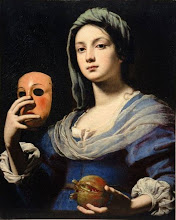Vladimir Solovyov (sometimes written in English as Soloviev) (1853-1900), was a Russian philosopher, poet and mystic. He is considered by many Western academics to be Russia's greatest philosopher.
Solovyov had three encounters with Sophia, the Divine Feminine.
Solovyov had three encounters with Sophia, the Divine Feminine.
The first encounter occurred in childhood. The second time he was in London, studying at the British Museum, and he saw her under the gold and azure dome of the Reading Room. He saw only her face, but he pleaded with her to see her full form.
"She asked him to meet her again in Egypt. He went to Egypt and Sophia once again appeared to him in the desert at dawn. This time she revealed herself to him fully, completely transforming him. She also showed him a vision of the Earth transfigured, all of nature, all things, unified within her form as the Divine Feminine. After his return to Russia, Solovyov briefly taught philosophy at Moscow University, but soon left because he disliked university politics. He then moved to St. Petersberg where he wrote and taught. Solovyov taught an engaged Christianity of service and activism, in which the binding power of Sophia - the Mother/Wisdom/Love nature of God - could heal the world. For Solovyov art could be a modern form of prophecy to bring greater awareness of this mystical unity to humanity. Among his many works of poetry, his masterpiece is Tri Svidaniya or "Three Meetings" describing his three mystical encounters with Sophia. In his poetry, his encounters with Sophia are permeated with radiant azure and violet.
Solovyov was a good friend of the great Russian novelist, Fyodor Dostoevsky."
- Source Poetry Chaikhana
What is, what was, what shall forever be -
All, all was held here in one steady gaze...
The seas and rivers blue beneath me,
Distant woods, snow-capped peaks.
I saw all, and all was one --
A single image of womanly beauty...
Pregnant with vastnesses!
Before me, in me -- only You.
All, all was held here in one steady gaze...
The seas and rivers blue beneath me,
Distant woods, snow-capped peaks.
I saw all, and all was one --
A single image of womanly beauty...
Pregnant with vastnesses!
Before me, in me -- only You.
-Vladimir Solovyev, Three Meetings, 1875



























